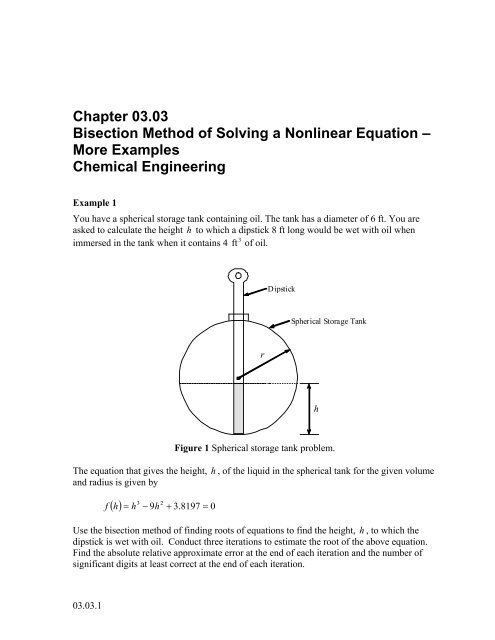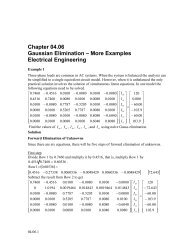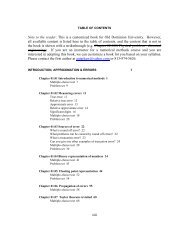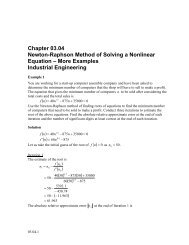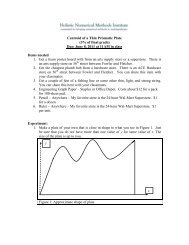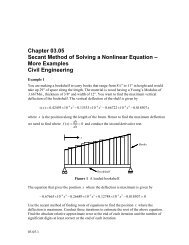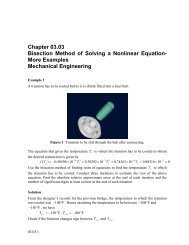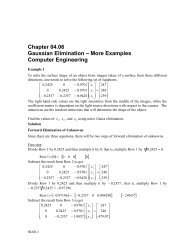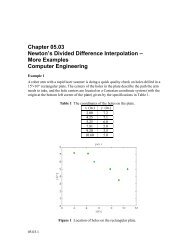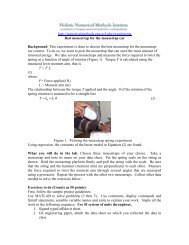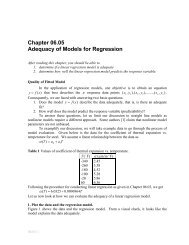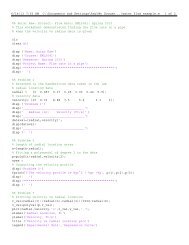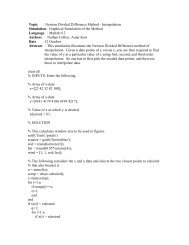Bisection Method of Solving a Nonlinear Equation â More Examples ...
Bisection Method of Solving a Nonlinear Equation â More Examples ...
Bisection Method of Solving a Nonlinear Equation â More Examples ...
You also want an ePaper? Increase the reach of your titles
YUMPU automatically turns print PDFs into web optimized ePapers that Google loves.
Chapter 03.03<br />
<strong>Bisection</strong> <strong>Method</strong> <strong>of</strong> <strong>Solving</strong> a <strong>Nonlinear</strong> <strong>Equation</strong> –<br />
<strong>More</strong> <strong>Examples</strong><br />
Chemical Engineering<br />
Example 1<br />
You have a spherical storage tank containing oil. The tank has a diameter <strong>of</strong> 6 ft. You are<br />
asked to calculate the height h to which a dipstick 8 ft long would be wet with oil when<br />
3<br />
immersed in the tank when it contains 4 ft <strong>of</strong> oil.<br />
Dipstick<br />
Spherical Storage Tank<br />
r<br />
h<br />
Figure 1 Spherical storage tank problem.<br />
The equation that gives the height, h , <strong>of</strong> the liquid in the spherical tank for the given volume<br />
and radius is given by<br />
f<br />
h<br />
h<br />
3 9h<br />
2 3.8197 0<br />
Use the bisection method <strong>of</strong> finding roots <strong>of</strong> equations to find the height, h , to which the<br />
dipstick is wet with oil. Conduct three iterations to estimate the root <strong>of</strong> the above equation.<br />
Find the absolute relative approximate error at the end <strong>of</strong> each iteration and the number <strong>of</strong><br />
significant digits at least correct at the end <strong>of</strong> each iteration.<br />
03.03.1
03.03.2 Chapter 03.03<br />
Solution<br />
From the physics <strong>of</strong> the problem, the dipstick would be wet between h 0 and h 2r ,<br />
where<br />
r radius <strong>of</strong> the tank,<br />
that is<br />
0 h 2r<br />
0 h 2(3)<br />
0 h 6<br />
Let us assume<br />
h <br />
0,<br />
hu<br />
6<br />
Check if the function changes sign between h and h .<br />
3 2<br />
0<br />
0 90 3.8197 3. 8197<br />
f ( h<br />
) f<br />
3 2<br />
f(h u<br />
) f (6) (6) 9(6) 3.8197 104.18<br />
Hence<br />
f h<br />
f<br />
hu<br />
<br />
f 0f<br />
6<br />
3.8197<br />
104.18 0<br />
So there is at least one root between h and h that is between 0 and 6.<br />
<br />
<br />
u<br />
Iteration 1<br />
The estimate <strong>of</strong> the root is<br />
h hu<br />
hm<br />
2<br />
0 6<br />
<br />
2<br />
3<br />
3 2<br />
f hm<br />
f 3 3 9 3 3.1897 50.<br />
180<br />
f h<br />
f<br />
hm<br />
<br />
f 0f<br />
3<br />
3.1897<br />
50.180 0<br />
Hence the root is bracketed between h<br />
and hm<br />
, that is, between 0 and 3. So, the lower and<br />
upper limits <strong>of</strong> the new bracket are<br />
h <br />
0,<br />
hu<br />
3<br />
At this point, the absolute relative approximate error <br />
a<br />
cannot be calculated, as we do not<br />
have a previous approximation.<br />
Iteration 2<br />
The estimate <strong>of</strong> the root is<br />
h hu<br />
hm<br />
2<br />
0 3<br />
<br />
2<br />
1.5<br />
u
<strong>Bisection</strong> <strong>Method</strong>-<strong>More</strong> <strong>Examples</strong>: Chemical Engineering 03.03.3<br />
3<br />
2<br />
h<br />
f 1.5<br />
<br />
1.5<br />
91.5<br />
3.8197 13.<br />
055<br />
h<br />
f<br />
h<br />
<br />
f 0f<br />
1.5<br />
<br />
3.8197<br />
13.055 0<br />
f<br />
m<br />
f<br />
<br />
m<br />
Hence, the root is bracketed between h<br />
and hm<br />
, that is, between 0 and 1.5. So the lower and<br />
upper limits <strong>of</strong> the new bracket are<br />
0,<br />
h 1.5<br />
h <br />
u<br />
The absolute relative approximate error<br />
<br />
a<br />
<br />
h<br />
h<br />
new old<br />
m m<br />
new<br />
hm<br />
100<br />
<br />
a<br />
at the end <strong>of</strong> Iteration 2 is<br />
1.5 3<br />
100<br />
1.5<br />
100%<br />
None <strong>of</strong> the significant digits are at least correct in the estimated root<br />
h m<br />
1.5<br />
as the absolute relative approximate error is greater that 5% .<br />
Iteration 3<br />
The estimate <strong>of</strong> the root is<br />
h hu<br />
hm<br />
2<br />
0 1.5<br />
<br />
2<br />
0.75<br />
h f 0.75 <br />
3<br />
2<br />
0.75 90.75 3.8197 0.<br />
82093<br />
h<br />
f<br />
h<br />
<br />
f 0f<br />
0.75<br />
3.8197<br />
0.82093 0<br />
f<br />
m<br />
f<br />
<br />
m<br />
Hence, the root is bracketed between h<br />
and hm<br />
, that is, between 0 and 0.75. So the lower<br />
and upper limits <strong>of</strong> the new bracket are<br />
0,<br />
h 0.75<br />
h <br />
u<br />
The absolute relative approximate error<br />
<br />
a<br />
<br />
h<br />
h<br />
new old<br />
m m<br />
new<br />
hm<br />
100<br />
<br />
a<br />
at the end <strong>of</strong> Iteration 3 is<br />
0.75 1.5<br />
100<br />
0.75<br />
100%<br />
Still none <strong>of</strong> the significant digits are at least correct in the estimated root <strong>of</strong> the equation as<br />
the absolute relative approximate error is greater than 5% .<br />
The height <strong>of</strong> the liquid is estimated as 0.75 ft at the end <strong>of</strong> the third iteration.<br />
Seven more iterations were conducted and these iterations are shown in Table 1.
03.03.4 Chapter 03.03<br />
Table 1 Root <strong>of</strong><br />
Iteration<br />
1<br />
2<br />
3<br />
4<br />
5<br />
6<br />
7<br />
8<br />
9<br />
10<br />
f<br />
th<br />
10<br />
x<br />
0<br />
h<br />
0.00<br />
0.00<br />
0.00<br />
0.00<br />
0.375<br />
0.5625<br />
0.65625<br />
0.65625<br />
0.65625<br />
0.66797<br />
as a function <strong>of</strong> the number <strong>of</strong> iterations for bisection method.<br />
hu<br />
6<br />
3<br />
1.5<br />
0.75<br />
0.75<br />
0.75<br />
0.75<br />
0.70313<br />
0.67969<br />
0.67969<br />
h %<br />
m<br />
3<br />
1.5<br />
0.75<br />
0.375<br />
0.5625<br />
0.65625<br />
0.70313<br />
0.67969<br />
0.66797<br />
0.67383<br />
f <br />
a<br />
----------<br />
100<br />
100<br />
100<br />
33.333<br />
14.286<br />
6.6667<br />
3.4483<br />
1.7544<br />
0.86957<br />
h m<br />
−50.180<br />
−13.055<br />
−0.82093<br />
2.6068<br />
1.1500<br />
0.22635<br />
−0.28215<br />
−0.024077<br />
0.10210<br />
0.039249<br />
At the end <strong>of</strong> the iteration,<br />
a<br />
0.86957%<br />
Hence the number <strong>of</strong> significant digits at least correct is given by the largest value <strong>of</strong> m<br />
which<br />
2m<br />
0 .510<br />
a<br />
2m<br />
0.86957 0.510<br />
2m<br />
1 .7391 10<br />
log 1.7391 2 m<br />
m 2 log1.7391<br />
1. 759<br />
So<br />
m 1<br />
The number <strong>of</strong> significant digits at least correct in the estimated root 0.67383 is 2.<br />
for<br />
NONLINEAR EQUATIONS<br />
Topic <strong>Bisection</strong> <strong>Method</strong>-<strong>More</strong> <strong>Examples</strong><br />
Summary <strong>Examples</strong> <strong>of</strong> <strong>Bisection</strong> <strong>Method</strong><br />
Major Chemical Engineering<br />
Authors Autar Kaw<br />
Date August 7, 2009<br />
Web Site http://numericalmethods.eng.usf.edu


